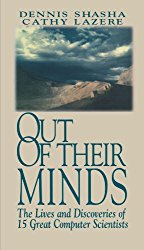“Out Of Their Minds” by Dennis Shasha and Cathy Lazere is an early (circa 1995) book on the lives of then-living 15 influential computer scientists - some well-known among the students of Computer Science, some not quite so well-known. The stated aim of the book is to get these people to talk about their inspirations, their contributions and where they see the future of their field. As it was published just around the time the world-wide web was becoming popular and computers in general were becoming ubiquitous, it provides very interesting perspectives and historical background.
The book is written in a clear and engaging manner, both for the lay person and the practising computer scientist. It does not shy from explaining some of the technical problems in order to illustrate the contributions of featured people. Readers are shown problems in, for example, graph theory, number theory, theory of computing, etc. that were solved by the featured computer scientists. The book thus does not insult the intelligence of the reader, unlike so many books that try to awkwardly straddle the human and technical aspects of their subjects and end up providing not much information about the technical contributions of the subjects in order to really appreciate them. Of course, the more serious reader will have to consult a technical paper or book to get even more details on a particular problem than those provided by this book, should they become curious about it.
The subjects of the book are divided into “Linguists”, “Algorithmists”, “Architects” and “Sculptors Of Machine Intelligence” - the last one being particularly awkward as the book was published just around the time that the last major AI Winter was setting in. Except for the last category, this is pretty much how most of us practitioners would categorize computer scientists.
It is interesting to see how most of the subjects arrived at Computer Science in a roundabout way - most of them dallying with physics, mathematics, biology, etc. first before giving Computer Science a go. Of course, this probably reflects the fact that Computer Science wasn’t yet a formal discipline at the time they were starting their careers. Nevertheless, they brought ideas and approaches from these more mature disciplines into this fledgling discipline and shaped it into what it is today. This cross-pollination has doubtless been helpful to the field. It is sad to this being lost in these days of narrow specializations and focus.
Apart from the insights this book provides into the lives and thoughts of these major computer scientists, it also provides a nice historical background to several of the discoveries and inventions in our field that I have not yet seen aggregated in such a way in any other book or paper. Just for that, it needs to be read by the serious student of Computer Science. Of course, even if you aren’t such a person, but are curious about the lives and thinking of very smart people or how one of the most impactful fields of modern times was formed, you ought to read this book.
